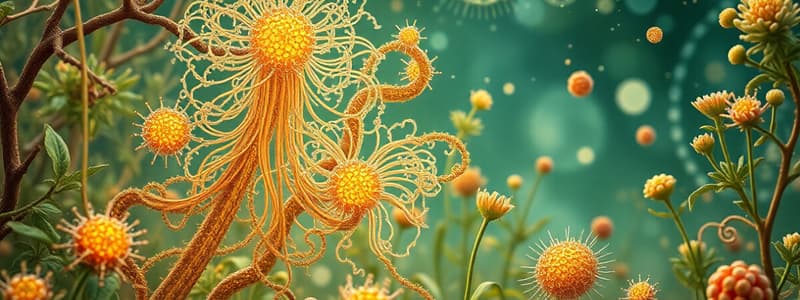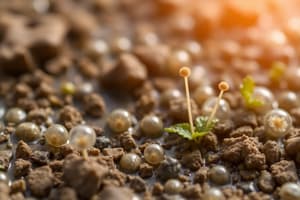Podcast
Questions and Answers
Which of the following microorganisms is NOT classified as a bacterium?
Which of the following microorganisms is NOT classified as a bacterium?
- Fungi (correct)
- Chlamydiae
- Rickettsiae
- Cyanobacteria
What is one major role that microorganisms play in the environment?
What is one major role that microorganisms play in the environment?
- Increasing the levels of sulfur in water bodies
- Breaking down dead organic matter (correct)
- Producing oxygen through photosynthesis
- Reducing the amount of nitrogen in soil
Which group of microorganisms includes both unicellular algae and protozoa?
Which group of microorganisms includes both unicellular algae and protozoa?
- Viruses
- Bacteria
- Fungi
- Protists (correct)
What shared characteristic defines microorganisms?
What shared characteristic defines microorganisms?
Which of the following elements is recycled by microorganisms in the environment?
Which of the following elements is recycled by microorganisms in the environment?
Flashcards
Microorganisms
Microorganisms
Organisms that are too small to be seen with the naked eye and can only be observed under a microscope.
Bacteria
Bacteria
A group of single-celled organisms that lack a nucleus and other membrane-bound organelles. They are found in diverse environments.
Fungi
Fungi
A diverse group of microorganisms including yeasts and molds. They are important for decomposing organic matter and producing food and medicine.
Viruses
Viruses
Signup and view all the flashcards
Protozoa
Protozoa
Signup and view all the flashcards
Study Notes
Microorganisms: Introduction
- Microorganisms are diverse and include bacteria, cyanobacteria, rickettsiae, chlamydiae, fungi, single-celled algae, protozoa, and viruses.
- All microorganisms share a common characteristic: they are only visible with a microscope.
Importance of Microorganisms
- Many microorganisms positively impact human life.
- They help maintain the balance of chemical compounds in the environment.
- They break down dead organic matter, recycling elements like carbon, nitrogen, sulfur, phosphorus, and others.
Studying That Suits You
Use AI to generate personalized quizzes and flashcards to suit your learning preferences.




